A soap bubble A of radius 0.03 m and another bubble B of radius 0.04 m are brought together, so that the combined bubble has a common interface of radius r, then the value of r is
0.24m
0.48m
0.12m
None of these
The correct Answer is:C
To solve the problem of finding the radius r of the common interface of two soap bubbles with given radii, we can follow these steps:
1. Identify the Given Values:
- Radius of bubble A, r1=0.03m
- Radius of bubble B, r2=0.04m
2. Understand the Concept of Excess Pressure:
- The excess pressure inside a soap bubble is given by the formula:
ΔP=4Sr
where S is the surface tension and r is the radius of the bubble.
3. Write the Excess Pressure for Both Bubbles:
- For bubble A:
ΔP1=4Sr1=4S0.03
- For bubble B:
ΔP2=4Sr2=4S0.04
4. Set Up the Pressure Difference Equation:
- When the two bubbles combine, the pressure difference between them can be expressed as:
ΔP′=ΔP1−ΔP2=4Sr
- Therefore, we have:
ΔP1−ΔP2=4Sr
5. Substituting the Excess Pressure Values:
- Substitute the expressions for ΔP1 and ΔP2:
4S0.03−4S0.04=4Sr
6. Simplifying the Equation:
- Factor out 4S:
4S(10.03−10.04)=4Sr
- Cancel 4S from both sides (assuming S≠0):
10.03−10.04=1r
7. Finding a Common Denominator:
- The common denominator for 0.03 and 0.04 is 0.12:
40.12−30.12=1r
- This simplifies to:
10.12=1r
8. Solving for r:
- Therefore, we find:
r=0.12m
Final Answer:
The radius r of the common interface is 0.12m.
---
- Radius of bubble A, r1=0.03m
- Radius of bubble B, r2=0.04m
- The excess pressure inside a soap bubble is given by the formula:
ΔP=4Sr
where S is the surface tension and r is the radius of the bubble.
- For bubble A:
ΔP1=4Sr1=4S0.03
- For bubble B:
ΔP2=4Sr2=4S0.04
- When the two bubbles combine, the pressure difference between them can be expressed as:
ΔP′=ΔP1−ΔP2=4Sr
- Therefore, we have:
ΔP1−ΔP2=4Sr
- Substitute the expressions for ΔP1 and ΔP2:
4S0.03−4S0.04=4Sr
- Factor out 4S:
4S(10.03−10.04)=4Sr
- Cancel 4S from both sides (assuming S≠0):
10.03−10.04=1r
- The common denominator for 0.03 and 0.04 is 0.12:
40.12−30.12=1r
- This simplifies to:
10.12=1r
- Therefore, we find:
r=0.12m
The radius r of the common interface is 0.12m.
Topper's Solved these Questions
- SURFACE TENSION Book:MHTCET PREVIOUS YEAR PAPERS AND PRACTICE PAPERSChapter:SURFACE TENSION Exercise:Exercise 2 (Miscellaneous Problems)
Explore 42 Videos
- SURFACE TENSION Book:MHTCET PREVIOUS YEAR PAPERS AND PRACTICE PAPERSChapter:SURFACE TENSION Exercise:MHT CET Corner
Explore 15 Videos
- SURFACE TENSION Book:MHTCET PREVIOUS YEAR PAPERS AND PRACTICE PAPERSChapter:SURFACE TENSION Exercise:MHT CET Corner
Explore 15 Videos
- STATIONARY WAVES Book:MHTCET PREVIOUS YEAR PAPERS AND PRACTICE PAPERSChapter:STATIONARY WAVES Exercise:MHT CET Corner
Explore 28 Videos
- WAVE MOTIONBook:MHTCET PREVIOUS YEAR PAPERS AND PRACTICE PAPERSChapter:WAVE MOTIONExercise:MHT CET CORNER
Explore 23 Videos
Similar Questions
A soap bubble of radius 1 cm expands into a bubble of radius 2 cm. Calculate the increase in surface energy if the surface tension for soap is 25 dyne/cm.
View SolutionA soap bubble of radius 6 cm and another bubble of 8 cm coalesce under isothermal xonditions in vacuum. The radius of the new bubble is
View Solution
Knowledge Check
Two soap bubbles one of radius 50 mm and the other of radius 80 mm are brought together so that they have a common interface.
(b) The radius of curvature of this interface attains which shape from smaller bubble towards larger bubble.AConvexBConcaveCPlaneDNoneTwo soap bubbles, one of radius 50mm and the other of radius 80mm, are brought in contact so that they have a common interface. The radius of the curvature of the common interface is
A0.003mB0.133mC1.2mD8.9mA soap bubble of radius r is placed on another bubble of radius 2r. The radius of the surface common to both the bubbles is
A2r3B3rC2rDr
If a soap bubble of radius 3 cm coalesce with another soap bubble of radius 4 cm under isothermal conditions the radius of the redultant bubble formed is in cm
View SolutionA soap bubble in vacuum has a radius of 3cm and another soap bubble in vacuum has a radius of 4cm. If the two bubbles coalesce under isothermal conditions then the radius of the new bubble is :
View SolutionA soap buble of radius 1.0 cm is formed inside another soap bubble of radius 2.0 cm . The radius of an another soap bubble which has the same pressure difference as that between the inside of the smaller and outside of large soap bubble , in metres is
View SolutionA soap - bubble with a radius 'r' is placed on another bubbles with a radius R (figure). Angles between the film at the point of contact will be -

View SolutionA soap bubble in vacuum has a radius of 3 cm ad another soap bubble in vacuum has a radius of 4 cm. if the two bubbles coalesce under isothermal condition, then the radius of the new bubble is
View Solution

